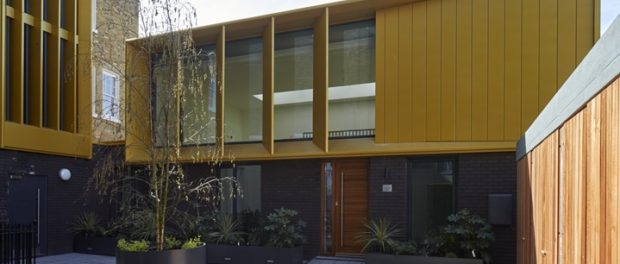Regancy Townhouse by Burwell Deakins Architects

Burwell Deakins Architects has completed a conversion of 23 Paradise Street, a Grade II-listed Regency era townhouse dating from 1814.
Located within King Edward III’s Rotherhithe Conservation Area and the curtilage of the Scheduled Monument of King Edward III’s Manor House, 23 Paradise Street is one of the few structures within the neighbourhood to survive the Blitz.
The building was originally used as a private dwelling for Sir William Gaitskell, then as a police station for over a century before being converted into offices in the 1960s.

Burwell Deakins Architects was commissioned by Hollybrook Homes – a family-owned residential and commercial developer – to transform the listed building for residential use in the form of seven apartments, including two duplex apartments at the lower levels.
The practice also completed a two-storey, three-bedroom house within the grounds of the original back garden and a four-storey, three-bedroom house abutting the northern gable of the original property where terraced housing was once located.
The new facades of the west wing utilise a combination of dark brickwork and bold yellow aluminium to create a framing system to provide an underlying order to the composition. The dark brick was chosen to allow continuity of texture and material within the context of a confident, contemporary composition.
 The house’s original interior partitions and features had been removed during the 1970s. Burwell Deakins reintroduced the historic room hierarchies – a freestanding kitchen sits within the new historic setting – and integrated modern services into the new fabric. A new external staircase provides access to the apartments located within the police station annex.
The house’s original interior partitions and features had been removed during the 1970s. Burwell Deakins reintroduced the historic room hierarchies – a freestanding kitchen sits within the new historic setting – and integrated modern services into the new fabric. A new external staircase provides access to the apartments located within the police station annex.
We designed the scale and sitting of the newbuild elements to be sympathetic to the original building while creating a subservient yet confident relationship between the two contrast structures. We are delighted to complete this conservation project, which truly embraces London’s old and new wealthy building stock.
Nicholas Burwell, director at Burwell Deakins Architects
 The new facades of the houses utilise a combination of dark brickwork and bold yellow aluminium to create a framing system that provides an underlying order to the composition. The dark brick was chosen to allow continuity of texture and material within the context of a confident, contemporary composition.
The new facades of the houses utilise a combination of dark brickwork and bold yellow aluminium to create a framing system that provides an underlying order to the composition. The dark brick was chosen to allow continuity of texture and material within the context of a confident, contemporary composition.
The material palette and detailing was agreed with the design and conservation officer by way of the construction of 1:1 mock-ups of critical building details. The black bricks were manufactured using the traditional soft-mud process that produces a non-uniform texture and the appearance of handmade or antique brick. This was desirable to allow continuity of texture between the old and new buildings and provides a textural contrast against the smooth surfaces of aluminium and glass. The bold yellow colour was selected to clearly articulate and pick out the confident, contemporary composition against the context of the dark brickwork and the existing building.
The proportions of the new buildings are intended to complement those of the existing. The two-storey house is expressed as a horizontal element sitting above its brick base and the existing boundary wall. The four-storey house has a vertical emphasis creating a bookend to the existing building on the Cathay Street elevation. Its roofline steps down to create a subservient relationship towards the existing house.
Chris Gilbert, associate at Burwell Deakins Architects
